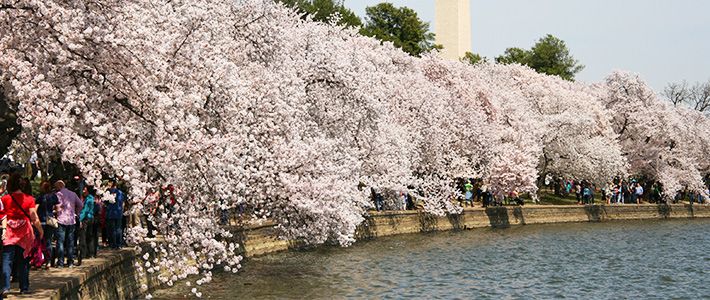
Sylvan Symbols of US-Japanese Exchange on the Potomac River
Politics Culture- English
- 日本語
- 简体字
- 繁體字
- Français
- Español
- العربية
- Русский
Washington DC’s National Cherry Blossom Festival draws more than 700,000 visitors annually. The visitors come to enjoy the cherry blossoms and the numerous related events held while the cherries are in bloom. Responsible for planning and running the festival in recent years is the nonprofit National Cherry Blossom Festival, Inc., whose directors include representatives of public- and private-sector organizations. This year’s festival kicked off on March 20 and continues through April 12.
The stars of the Washington DC cherry-blossom viewing are, as in Japan, trees of the Yoshino variety (Prunus × yedoensis; Japanese: somei-yoshino). Yoshino cherry trees’ pale pink blooms are the flowers that we associate most closely with cherry-blossom season, and these account for the vast majority of the trees in Washington. But the stand also includes hundreds of Kwanzan cherries (Prunus serrulata), which bloom about two weeks after the Yoshino trees, and several other varieties, including the weeping Japanese cherry (Prunus subhirtella var. pendula), which blooms about a week before its Yoshino cousin.
Washington DC received the initial gift of cherry trees—about 2,000—from Tokyo in 1910. An inspection revealed, however, that the trees carried insect pests and disease, and the US president, William Howard Taft (1857–1930, president 1909–13), reluctantly ordered their burning to protect US agriculture. Tokyo followed up with a gift of more than 3,000 trees in 1912. Those consisted of cuttings from a famous Tokyo stand along the Arakawa River grafted onto saplings from Itami, in present-day Hyōgo Prefecture.
The plantings along the Potomac took hold and earned the affection of Washington residents and visitors. So deep was that affection that the stand received loving care even during the darkest days of World War II.
Spring Comes Late to the Festival
I had the opportunity to visit Washington recently during what I had hoped would be the cherry-blossom season. Lingering winter cold and snowfall, however, had delayed the spectacle. Ice covered large swaths of the Potomac, and the cherry trees along the banks betrayed no signs of breaking into bloom. The air was nonetheless rich with a sense of anticipation.
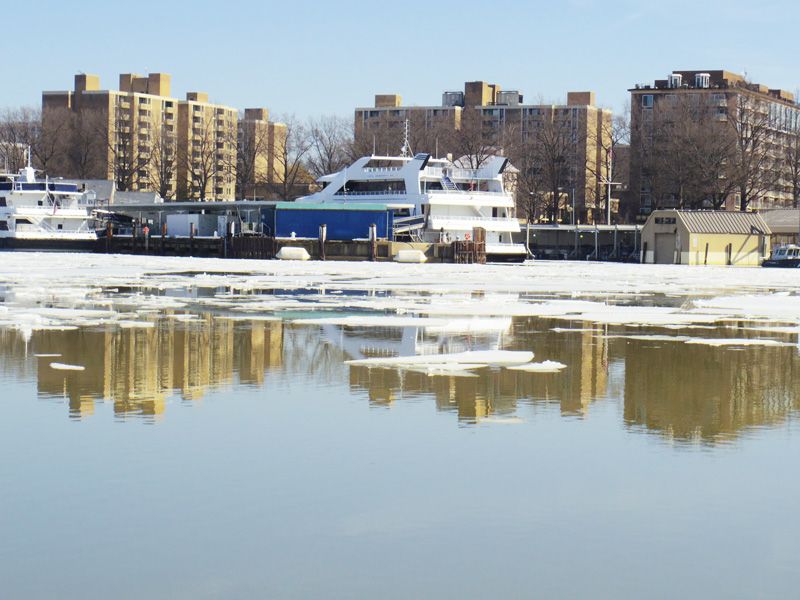 Ice and snow atop the Potomac testified to the lingering cold that delayed this year’s blossoming.
Ice and snow atop the Potomac testified to the lingering cold that delayed this year’s blossoming.
We mark this year the seventieth anniversary of the end of World War II. And the Japanese embassy, the Japan-America Society of Washington DC, and Japanese public- and private-sector organizations are devoting even more attention than usual to the National Cherry Blossom Festival. A prime focus of that attention is the annual Sakura Matsuri street festival. That event, the largest one-day celebration of Japanese culture in the United States, takes place this year on April 11.
Another focus of Japanese participation in the National Cherry Blossom Festival is the official opening ceremony, held this year on March 21. On hand to provide entertainment was a stellar cast of American and Japanese musical artists: the soulful-voiced Debórah Bond, the jazz pianist Morita Manami, the traditional Japanese instrumentalists of the AUN-J Classic Orchestra, and the pop singer Watanabe Misato. And the organizers came up with cherry blossoms from somewhere to provide the requisite atmosphere.
The National Cherry Blossom Festival is also replete with other Japan-themed events. Visitors can take in presentations about sushi and sake, visit exhibits of Japanese animation and photography, attend a kimono fashion show, enjoy a performance of rakugo comedic storytelling, or even take part in a kite-flying tournament.
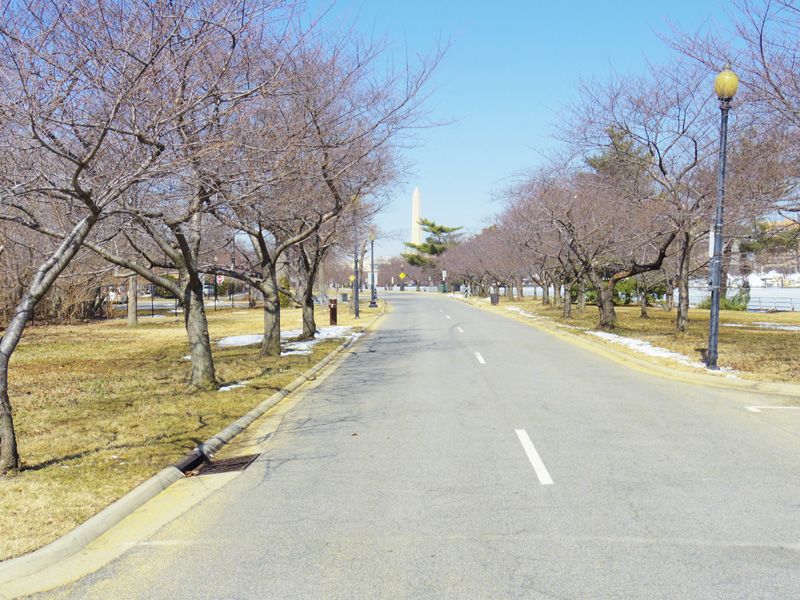 The cherry trees along the Potomac were still keeping their charms under wraps this year in mid-March.
The cherry trees along the Potomac were still keeping their charms under wraps this year in mid-March.
A Quarter-Century Gestation
Planting cherry trees in Washington DC was the brainchild of the travel writer Eliza Scidmore (1856–1928). A prolific fount of articles and books, Scidmore would become the first female member of the National Geographic Society’s board of managers. She fell in love with Japan’s cherry blossoms during a visit to the nation in 1885. Back in the United States, she proposed a planting in Washington on reclaimed land along the Potomac. She was persistent, but her perseverance failed to persuade the US Army, which was responsible for managing public land and facilities in the capital.
Scidmore’s proposal gestated for 24 years but finally came to fruition with the assistance of Japan’s consul general in New York, Mizuno Kōkichi (1873–1914). This information is courtesy of a former Japanese ambassador to the United States, Fujisaki Ichirō (1947–, US ambassador 2008–12). Fujisaki’s term as US ambassador coincided with the 100th anniversary of the original planting of the sylvan gift from Tokyo.
Mizuno’s exploits as a diplomat, according to Fujisaki, included participating in coordinating the attack on Russia’s naval base at Port Arthur and in securing the safety of Japanese nationals in the area. Russia leased the Port Arthur base from the Chinese government in what is now the Lushunkou district of Dalian, Liaoning Province. Japan’s attack on the base marked the beginning of the Russo-Japanese War (1904–5), which ended with the signing of the Treaty of Portsmouth in September 1905. The US government engineered that treaty, so Mizuno had a strong sense of gratitude toward the United States.
▼More to view
|
Scidmore met Mizuno while he was serving as Japan’s consul general in New York and described her idea for planting Japanese cherry trees in Washington DC. Mizuno regarded the idea as an excellent way to demonstrate Japanese appreciation to the United States. He also regarded it as a valuable way to help forestall the escalating US antipathy toward Japanese immigrants. The idea took big step toward fruition through a chance encounter. Mizuno and Scidmore happened to run into the chemist Takamine Jōkichi (1854–1922) in Washington in April 1909.
Takamine had made a fortune from his success in isolating the enzyme takadistase, which became a widely prescribed digestive aid, and had emigrated to the United States and established a research laboratory in New York. There he had gained fame for successfully isolating the hormone adrenaline in 1901. And he had become the de facto leader of the Japanese community in New York.
Scidmore and Mizuno described the cherry-planting idea to Takamine. The latter shared Mizuno’s concern about the growing anti-Japanese sentiment in the United States, and he agreed that the cherry trees could be a useful antidote. During the discussion, Scidmore reported that she had pitched the idea to President Taft’s wife, Helen (1861–1943), and that the First Lady had been extremely receptive. The three thereupon resolved to secure the cooperation of the Japanese government.
Overcoming an Inauspicious Beginning
Mizuno routed the proposal through the Foreign Ministry, and the foreign minister, Komura Jutarō (1855–1911, foreign minister 1901–6 and 1908–11) requested assistance from the mayor of Tokyo, Ozaki Yukio (1858–1954, Tokyo mayor 1903–12). Ozaki had exhibited an international perspective throughout his career, and he shared Mizuno and Takamine’s sense of gratitude toward the United States for engineering the Treaty of Portsmouth. He promptly secured a budget to prepare and ship 2,000 cherry saplings to Washington DC. The shipment left in January 1910, but insect pests and disease afflicted most of the saplings during the long sea voyage. And as noted above, the cargo needed to be incinerated on arrival in the United States.
Undeterred, Ozaki issued instructions to come up with saplings that would resist insects and disease. His silviculturists arrived at the solution, also noted above, of grafting cuttings from famously beautiful cherries along the Arakawa River in Tokyo onto hardy saplings from Itami. They further safeguarded the shipment by fumigating the saplings with hydrogen cyanide gas.
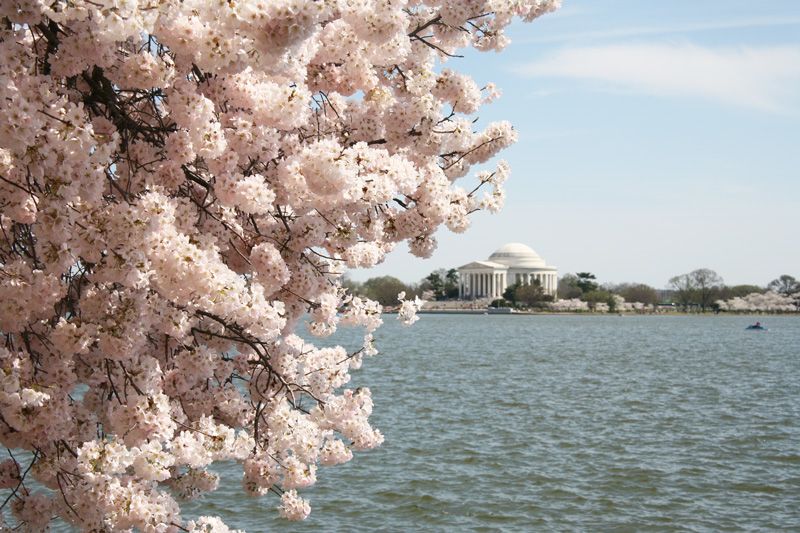 The Potomac cherries display their full glory in April 2014, as seen from WashingtonDC’s Tidal Basin reservoir. Visible in the background is the Jefferson Monument.
The Potomac cherries display their full glory in April 2014, as seen from WashingtonDC’s Tidal Basin reservoir. Visible in the background is the Jefferson Monument.
Second Time’s the Charm
Tokyo’s second cherry-tree shipment, this one comprising 3,020 saplings of 12 varieties, left the port of Yokohama in February 1912. The careful preparations and precautions proved effective, and the shipment arrived safe and sound. Neither insects nor disease had damaged a single sapling.
The commemorative planting ceremony took place on March 27, attended by First Lady Helen Taft and other dignitaries, and the trees were soon growing vigorously into the famously impressive stand that they have become. Today, the stand spans East Potomac Park, the land around the Tidal Basin, and the grounds of the Washington Monument.
One of the Washington DC cherries, interestingly, has made its way back to Itami. In that city’s Higashino district stands the Satogaeri-zakura (Homecoming Cherry). That tree arrived as a sapling in 2003—a gift from the US capital to mark the ninetieth anniversary of the first planting.
Postscript: Objections from Japan’s Asian Neighbors
The enduring popularity of the National Cherry Blossom Festival and its Japanese overtones have invited critical attention from China, Korea, and other Asian nations. Japan’s neighbors call for repositioning this springtime attraction on the Washington DC calendar as a pan-Asian event.
Accompanying Korea’s objection to the festival are grievances botanical and historical. The Yoshino cherry, claims the Korean government, originated not in Japan but in Korea. Underlying the Korean dissatisfaction are the terms of the Treaty of Portsmouth, which acknowledged Japanese hegemony over the Korean Peninsula. Yet whatever the merits of the Korean claims, the objections would seem at odds with the arboreal aims of Eliza Scidmore and Helen Taft.
(Originally written in Japanese by Harano Jōji of Nippon.com and published on March 25, 2015. Banner photo: Cherry trees in full bloom embellish the periphery of Washington DC’s Tidal Basin in April 2014.)
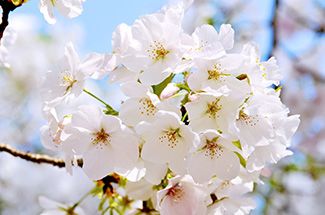 Cherry Blossom Landscapes
Cherry Blossom Landscapes